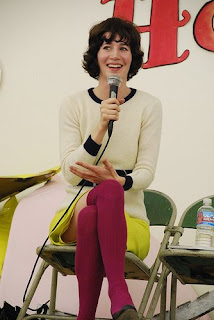I’ve seen a lot of interesting discussion on blogs today about responsible marketing. Drew McLellan weighs in, talking about Barry Bonds, as does the responsible marketing blog. Both are discussing how easy it is to end up with a permanent asterisk next to your name. I discussed marketing and reputation in my American Apparel post; these guys take it farther and lay it out really well. Neither is talking about NGOs, but the lessons are the same.
Author: Alanna Shaikh
What I learned from reality TV
I spent the 4th of July weekend watching television. The weather was muggy, we all had colds, my dad can’t walk much, and my car is on summer vacation with my mom. That translated to a weekend spent sleeping and staring at the box. I didn’t expect to get anything out of my three days off except eliminating a sleep deficit. It turns out, though, that you can find insight almost anywhere, even on “The Next Food Network Star.” I did promise, after all, that I’d look everywhere I could for ways to do international development better.
This is what I learned: It’s all about relationships. Even when people are competing head-to-head, they still want to like others and be liked in return. Everyone wants a human connection, even when that desire works against their immediate self interest. It’s an obvious lesson, but one that’s easy to forget or ignore.
What does this mean for development projects? Well, when you are working to improve health care, you’ll see better outcomes if people have the same doctor every time. Teenagers are more likely to use drugs (or condoms – it goes both ways) if they believe their friends are doing so. People repay microfinance loans, and stand fast in the heat of battle, so they won’t lose face in front of their peers.
Lesson: When you are designing programs, take relationships into account as a major motivator.
Jargon of the day: Domestic Disparity Indicator
I was secretly excited when I ran into this phrase today, because it sounds so totally meaningless.
Phrase: Domestic Disparity Indicator
Translation: Any way you can find to measure the divide between rich and poor in a country. Domestic because you’re measuring just one country, disparity because what you want to know is how rich are the rich and how poor are the poor, and indicator because you’re looking for some kind of thing you can measure. The percentage of land belonging to the richest 10% of the population, for example, would be a domestic disparity indicator.
Jargon of the day 7/8/08
This is a new daily feature: each day I’ll give you a jargony word or phrase I heard that day, along with my unscientific translation.
So, today’s jargon: Private sector distribution system
Translation: This was in the context of distributing food aid, so what it means is trucking companies. Businesses – not government or donor agencies – who can carry food around the country.
Things I believe in #44 – Camels
Once upon a time, I was at a dinner in rural Turkmenistan. I’d been invited home by a local health official, after an award ceremony for the visiting health nurses in the district who did the best job of educating parents of young children about diarrhea. The meal was huge, and multi-course, in keeping with Turkmen tradition. Towards the end, as we were all starting to list a bit on our floor pillows, the official began to talk about camels.
You see them everywhere in Turkmenistan, camels. They’re as common as cows in American farm country. You get used to them quickly. Once I’d gotten over the novelty, I hadn’t thought twice about camels until that dinner. The official had grown up in the rural district which he now served as head doctor. As a young boy, he’d been in charge of his family’s camels. They had 15, which he swore were easier to care for than just two cows. He spent a good 30 minutes telling us about the special and wonderful characteristics of camels.
Once I started learning about camels, though, I realized I should have been paying attention all along. Camels can handle changes in body temperature and levels of dehydration that would kill any other mammal. Camel milk has better nutritional value than cow’s milk – more milk and more fat. It makes fabulous yogurt. Camel meat is flavorful and lean, if a bit tough.(1) Contrary to commonly-held beliefs, camels are patient, good-tempered, and placid by nature.(2) They’re intelligent enough to be trained like horses, and can carry up to 990 pounds.
During the 1984-85 African drought, cows, sheep, and goats died but the camels made it through. Their owners, in turn, were more likely to live through the famine. Camels are good livestock. They’re hardy, long-lived, cheap to feed and easy to care for. They are the kind of livestock that can lift a family out of poverty.
(1) I’ve never tried camel dairy, but I’ve eaten camel meat. It’s chewy and spicy.
(2) Though I have been told they are puppy killers.
(no photo credit – I took this one with my own hands)
Telling better stories

Once, at a restaurant, I ordered “Crispy potato wedges with sweet and sour dipping sauce” as an appetizer. What I got was French fries and ketchup. The description on the menu was true, but not honest. I didn’t feel like I could complain to the manager, but it left me feeling disappointed and vaguely deceived.
Too much of our communication about international development is true but not honest. We boil complicated situations down into simple ideas. We pretend there are easy answers to problems so difficult there may be no answers at all. We use emotional impact and compelling photographs to avoid detailed discussion of the challenges of doing good development work.
And we need our stories, because our stories are what bring us funding. Whether it’s a government agency, a foundation, a corporate partner, or a little old lady putting a five dollar bill in an envelope, the people who give us money respond to stories. The government calls it reporting, corporations ask for success stories, and regular people just want reasons to give their cash, but they are all asking for stories to explain what we do and why we deserve their money to do it.
For a long time, were stuck with our oversimplified, easily digested stories. Our true-but-not-real stories were all we could get out to the world. Three minute spots on the evening news and press releases don’t leave much room for nuance. Even reporters from respected media outlets rarely have the time or expertise to research and relay a complicated article about the realities of international development.
The world has changed. We have now have a huge selection of social media tools we can use to shape our own messages and communicate directly. And – we can do more than just put a message out there in an electronic bottle and hope someone finds it. We can have conversations about what we do, how we do it, and how people can be part of that. We don’t have to spoon feed people easy ideas because we’ve got the time and space to talk about the hard stuff.
This is my challenge to you:
Think seriously about what social media can do for you. Don’t just use your Twitter account for mini-press releases; use it for genuinely new information as it happens. Imagine a country director in Darfur tweeting as he travels to a refugee camp. Imagine a collaborative blog by your HQ staff, talking about what backstopping actually entails. (People would be a lot more likely to pay overhead if they knew what overhead was.) Imagine your Sri Lanka country team posting their photos to Flickr and their videos to YouTube. Imagine your website as a portal to all of that, a place people go to get deep knowledge about what your organization does. Imagine turning all your donors into passionate advocates who encourage others to give too.
Better stories can do that for us, and we finally have a way to tell them.
Photo Credit: Miranda July at Modern Times, taken by Steve Rhodes.
Link I like
I wanted to point out this great blog – Mostly Maurice. It’s a caustic and realistic perspective on development in Africa. One of my favorite posts is this one on Donor Dumping.

